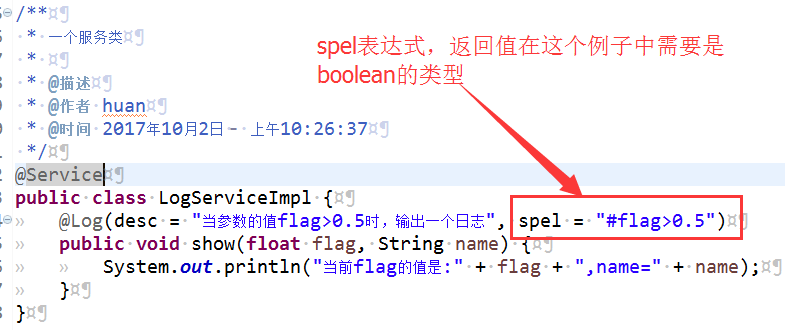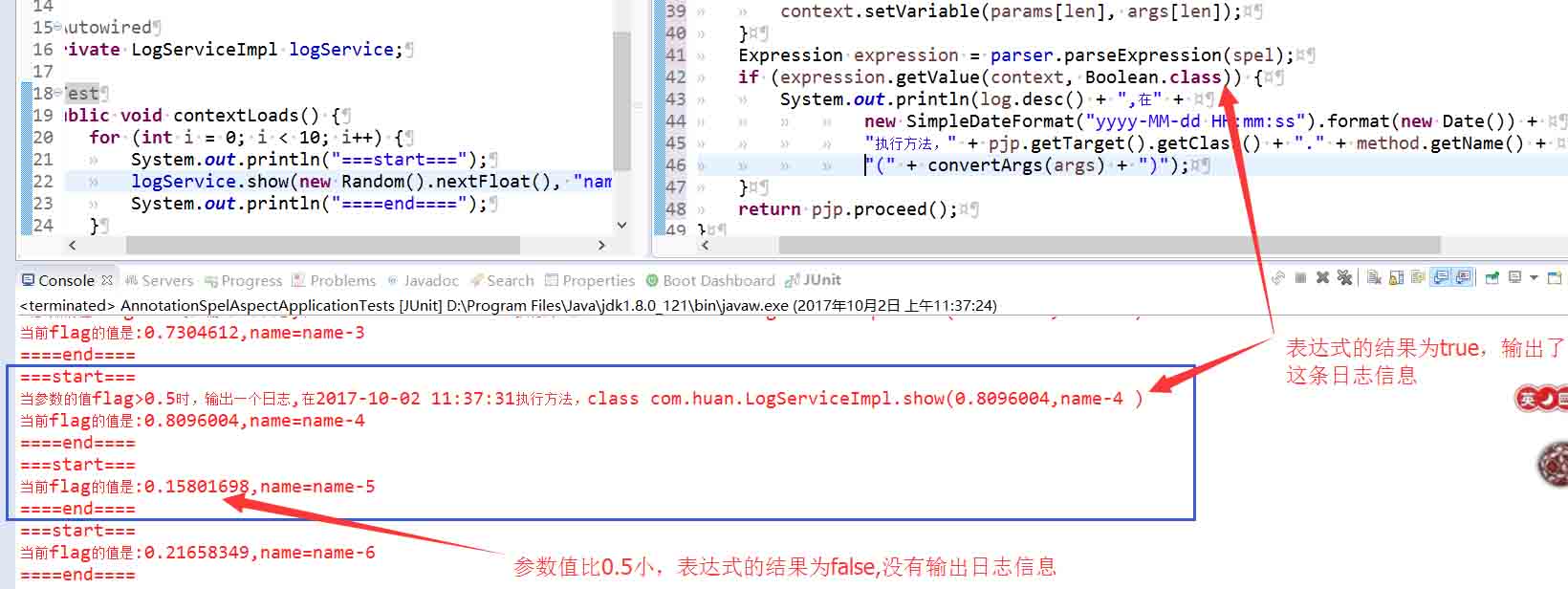您好,登錄后才能下訂單哦!
您好,登錄后才能下訂單哦!
這篇文章主要介紹了如何使用Springboot自定義注解并支持SPEL表達式,具有一定借鑒價值,感興趣的朋友可以參考下,希望大家閱讀完這篇文章之后大有收獲,下面讓小編帶著大家一起了解一下。
舉例,自定義redis模糊刪除注解
import java.lang.annotation.ElementType;
import java.lang.annotation.Retention;
import java.lang.annotation.RetentionPolicy;
import java.lang.annotation.Target;
@Target(ElementType.METHOD)
@Retention(RetentionPolicy.RUNTIME)
public @interface CacheEvictFuzzy {
/**
* redis key集合,模糊刪除
* @return
*/
String[] key() default "";
}import org.apache.commons.lang3.StringUtils;
import org.aspectj.lang.ProceedingJoinPoint;
import org.aspectj.lang.annotation.AfterThrowing;
import org.aspectj.lang.annotation.Around;
import org.aspectj.lang.annotation.Aspect;
import org.aspectj.lang.annotation.Pointcut;
import org.aspectj.lang.reflect.MethodSignature;
import org.slf4j.Logger;
import org.slf4j.LoggerFactory;
import org.springframework.beans.factory.annotation.Autowired;
import org.springframework.core.LocalVariableTableParameterNameDiscoverer;
import org.springframework.core.annotation.Order;
import org.springframework.expression.ExpressionParser;
import org.springframework.expression.spel.standard.SpelExpressionParser;
import org.springframework.expression.spel.support.StandardEvaluationContext;
import org.springframework.stereotype.Component;
import java.lang.reflect.Method;
import java.util.Set;
@Aspect
@Order(1)
@Component
public class CacheCleanFuzzyAspect {
Logger logger = LoggerFactory.getLogger(this.getClass());
@Autowired
private RedisUtil redis;
//指定要執行AOP的方法
@Pointcut(value = "@annotation(cacheEvictFuzzy)")
public void pointCut(CacheEvictFuzzy cacheEvictFuzzy){}
// 設置切面為加有 @RedisCacheable注解的方法
@Around("@annotation(cacheEvictFuzzy)")
public Object around(ProceedingJoinPoint proceedingJoinPoint, CacheEvictFuzzy cacheEvictFuzzy){
return doRedis(proceedingJoinPoint, cacheEvictFuzzy);
}
@AfterThrowing(pointcut = "@annotation(cacheEvictFuzzy)", throwing = "error")
public void afterThrowing (Throwable error, CacheEvictFuzzy cacheEvictFuzzy){
logger.error(error.getMessage());
}
/**
* 刪除緩存
* @param proceedingJoinPoint
* @param cacheEvictFuzzy
* @return
*/
private Object doRedis (ProceedingJoinPoint proceedingJoinPoint, CacheEvictFuzzy cacheEvictFuzzy){
Object result = null;
//得到被切面修飾的方法的參數列表
Object[] args = proceedingJoinPoint.getArgs();
// 得到被代理的方法
Method method = ((MethodSignature) proceedingJoinPoint.getSignature()).getMethod();
String[] keys = cacheEvictFuzzy.key();
Set<String> keySet = null;
String realkey = "";
for (int i = 0; i < keys.length; i++) {
if (StringUtils.isBlank(keys[i])){
continue;
}
realkey = parseKey(keys[i], method, args);
keySet = redis.keys("*"+realkey+"*");
if (null != keySet && keySet.size()>0){
redis.delKeys(keySet);
logger.debug("攔截到方法:" + proceedingJoinPoint.getSignature().getName() + "方法");
logger.debug("刪除的數據key為:"+keySet.toString());
}
}
try {
result = proceedingJoinPoint.proceed();
} catch (Throwable throwable) {
throwable.printStackTrace();
}finally {
return result;
}
}
/**
* 獲取緩存的key
* key 定義在注解上,支持SPEL表達式
* @return
*/
private String parseKey(String key, Method method, Object [] args){
if(StringUtils.isEmpty(key)) return null;
//獲取被攔截方法參數名列表(使用Spring支持類庫)
LocalVariableTableParameterNameDiscoverer u = new LocalVariableTableParameterNameDiscoverer();
String[] paraNameArr = u.getParameterNames(method);
//使用SPEL進行key的解析
ExpressionParser parser = new SpelExpressionParser();
//SPEL上下文
StandardEvaluationContext context = new StandardEvaluationContext();
//把方法參數放入SPEL上下文中
for(int i=0;i<paraNameArr.length;i++){
context.setVariable(paraNameArr[i], args[i]);
}
return parser.parseExpression(key).getValue(context,String.class);
}
}完事啦!
大家可以注意到關鍵方法就是parseKey
/**
* 獲取緩存的key
* key 定義在注解上,支持SPEL表達式
* @return
*/
private String parseKey(String key, Method method, Object [] args){
if(StringUtils.isEmpty(key)) return null;
//獲取被攔截方法參數名列表(使用Spring支持類庫)
LocalVariableTableParameterNameDiscoverer u = new LocalVariableTableParameterNameDiscoverer();
String[] paraNameArr = u.getParameterNames(method);
//使用SPEL進行key的解析
ExpressionParser parser = new SpelExpressionParser();
//SPEL上下文
StandardEvaluationContext context = new StandardEvaluationContext();
//把方法參數放入SPEL上下文中
for(int i=0;i<paraNameArr.length;i++){
context.setVariable(paraNameArr[i], args[i]);
}
return parser.parseExpression(key).getValue(context,String.class);
}在我們的實際開發中可能存在這么一種情況,當方法參數中的某些條件成立的時候,需要執行一些邏輯處理,比如輸出日志。而這些代碼可能都是差不多的,那么這個時候就可以結合自定義注解加上切面加上spel表達式進行處理。就比如在spring中我們可以使用@Cacheable(key="#xx")實現緩存,這個#xx就是一個spel表達式。
需求:我們需要將service層方法中方法的某個參數的值大于0.5的方法,輸出方法執行日志。(需要了解一些spel表達式的語法)
實現步驟:
1、自定義一個注解Log
2、自定義一個切面,攔截所有方法上存在@Log注解修飾的方法
3、寫一個service層方法,方法上標注@Log注解
難點:
在切面中需要拿到具體執行方法的方法名,可以使用spring提供的LocalVariableTableParameterNameDiscoverer來獲取到
注意:注解中的spel的值是必須的,且spel表達式返回的結果應該是一個布爾值
/**
* 記錄日志信息,當spel表但是中的值為true時,輸出日志信息
*
* @描述
* @作者 huan
* @時間 2017年10月2日 - 上午10:25:39
*/
@Target({ ElementType.METHOD })
@Retention(RetentionPolicy.RUNTIME)
public @interface Log {
String spel();
String desc() default "描述";
}
注意一下解析spel表達式中context的設值即可
/**
* 日志切面,當條件滿足時輸出日志.
*
* @描述
* @作者 huan
* @時間 2017年10月2日 - 上午10:32:16
*/
@Component
@Aspect
public class LogAspect {
ExpressionParser parser = new SpelExpressionParser();
LocalVariableTableParameterNameDiscoverer discoverer = new LocalVariableTableParameterNameDiscoverer();
@Around("@annotation(log)")
public Object invoked(ProceedingJoinPoint pjp, Log log) throws Throwable {
Object[] args = pjp.getArgs();
Method method = ((MethodSignature) pjp.getSignature()).getMethod();
String spel = log.spel();
String[] params = discoverer.getParameterNames(method);
EvaluationContext context = new StandardEvaluationContext();
for (int len = 0; len < params.length; len++) {
context.setVariable(params[len], args[len]);
}
Expression expression = parser.parseExpression(spel);
if (expression.getValue(context, Boolean.class)) {
System.out.println(log.desc() + ",在" + new SimpleDateFormat("yyyy-MM-dd HH:mm:ss").format(new Date()) + "執行方法," + pjp.getTarget().getClass() + "." + method.getName()
+ "(" + convertArgs(args) + ")");
}
return pjp.proceed();
}
private String convertArgs(Object[] args) {
StringBuilder builder = new StringBuilder();
for (Object arg : args) {
if (null == arg) {
builder.append("null");
} else {
builder.append(arg.toString());
}
builder.append(',');
}
builder.setCharAt(builder.length() - 1, ' ');
return builder.toString();
}
}<parent> <groupId>org.springframework.boot</groupId> <artifactId>spring-boot-starter-parent</artifactId> <version>1.5.2.RELEASE</version> <relativePath/> <!-- lookup parent from repository --> </parent> <properties> <project.build.sourceEncoding>UTF-8</project.build.sourceEncoding> <project.reporting.outputEncoding>UTF-8</project.reporting.outputEncoding> <java.version>1.8</java.version> </properties> <dependencies> <dependency> <groupId>org.springframework.boot</groupId> <artifactId>spring-boot-starter-aop</artifactId> </dependency> <dependency> <groupId>org.springframework.boot</groupId> <artifactId>spring-boot-starter-test</artifactId> <scope>test</scope> </dependency> </dependencies> <build> <plugins> <plugin> <groupId>org.springframework.boot</groupId> <artifactId>spring-boot-maven-plugin</artifactId> </plugin> </plugins> </build>

1、當我們想在自己寫的spel表達式中調用spring bean 管理的方法時,如何寫。spel表達式支持使用 @來引用bean,但是此時需要注入BeanFactory

感謝你能夠認真閱讀完這篇文章,希望小編分享的“如何使用Springboot自定義注解并支持SPEL表達式”這篇文章對大家有幫助,同時也希望大家多多支持億速云,關注億速云行業資訊頻道,更多相關知識等著你來學習!
免責聲明:本站發布的內容(圖片、視頻和文字)以原創、轉載和分享為主,文章觀點不代表本網站立場,如果涉及侵權請聯系站長郵箱:is@yisu.com進行舉報,并提供相關證據,一經查實,將立刻刪除涉嫌侵權內容。